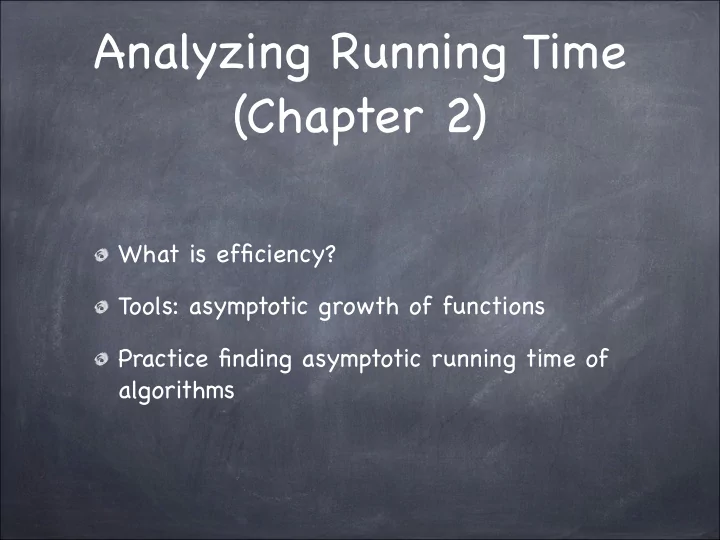

Analyzing Running Time (Chapter 2) What is efficiency? Tools: asymptotic growth of functions Practice finding asymptotic running time of algorithms
Is My Algorithm Efficient? Idea: Implement it, time how long it takes. Problems? Effects of the programming language? Effects of the processor? Effects of the amount of memory? Effects of other things running on the computer? Effects of the input values? Effects of the input size?
Worst-Case Running Time Worst-case running time: bound the largest possible running time on any input of size N Seems pessimistic, but: Effective in practice Hard to find good alternative (e.g., average case analysis)
Brute Force Good starting point for thinking about efficiency: can we do better than a “brute force” solution? What is the brute force solution for the stable matching problem?
Worst-case: Gale-Shapley vs. Brute Force # Colleges 4 8 16 N G-S 16 64 256 N 2 Brute Force 24 40,320 20,922,789,888,000 N!
Working Definition of Efficient Efficient = better than brute force Desired property: if input size increases by constant factor algorithm slows down by a constant factor E.g. size N -> 2N, time T -> 4T
Polynomial Time Definition: an algorithm runs in polynomial time if Number of steps is at most c * N d , where N is input size, and c and d are constants Does this satisfy desired property? If there is no polynomial time solution, we say there is no efficient solution.
Running Times as Functions of Input Size
Asymptotic Growth: Big O(), Ω (), Θ () Goal: build tools to help coarsely classify algorithm’ s running times Running time = number of primitive “steps” (e.g., line of code or assembly instruction) 1.62 n 2 + 3.5 n + 8 Coarse: is too detailed
Notation Let T(n) be a function that defines the worst-case running time of an algorithm. For the remainder of the lecture, we assume that all functions T(n), f(n), g(n), etc. are nonnegative
Big O Notation T(n) is O(f(n)) if T(n) ≤ c · f(n), where c ≥ 0 for all n ≥ n 0 (Example on board) O(n) is the asymptotic upper bound of T(n).
Visualizing Asymptotics 4n 3n + 2 n 0 = 2 T(n) = 3n + 2 is O(n)
Ω Notation T(n) is Ω (f(n)) if T(n) ≥ c · f(n), where c ≥ 0 for all n ≥ n 0 (Example on board) Ω (n) is the asymptotic lower bound of T(n).
Visualizing Asymptotics 3n + 2 n n 0 = 0 T(n) = 3n + 2 is Ω (n)
Θ Notation T(n) is Θ (f(n)) if T(n) is O(n) and T(n) is Ω (n) (Example on board) Θ (n) is the asymptotic tight bound of T(n).
Visualizing Asymptotics 4n 3n + 2 n T(n) = 3n + 2 is Θ (n)
O(), Ω (), Θ () O() - upper bound T(n) ≤ c · f(n), where c ≥ 0 for all n ≥ n 0 Ω () - lower bound T(n) ≥ c · f(n), where c ≥ 0 for all n ≥ n 0 Θ () - tight bound Both O() and Ω ()
Properties of O(), Ω (), Θ ()
Transitivity Claim: (a) If f = O(g) and g = O(h), then f = O(h) (b) If f = Ω (g) and g = Ω (h), then f = Ω (h) (b) If f = Θ (g) and g = Θ (h), then f = Θ (h) Prove (a) on board
Additivity Claim: (a) If f = O(h) and g = O(h), then f+g = O(h) (b) If f 1 , f 2 , ..., f k are each O(h), then f 1 + f 2 + ...+ f k is O(h) (c) If f = O(g), then f+g = Θ (g) Prove (a) on board; discuss (c)
Asymptotic Bounds For Common Functions
Polynomial Time Claim: Let T(n) = c 0 + c 1 n + c 2 n 2 + ... + c d n d , where c d is positive. Then T(n) is Θ (n d ). Proof: repeated application of the additivity rule (c) New definition of polynomial-time algorithm: running time T(n) is O(n d )
Logarithm Review b c = a Defn: is the unique number c s.t. log b ( a ) “log base b of a”: Informally, the number of times you can divide a into b parts before each has size one Facts: log b ( b n ) = n b log b ( n ) = n log a ( n ) = log b ( n ) log a ( n ) = Θ ( log b ( n )) log b ( a )
Other Asymptotic Orderings Logarithms: log a n is O(n d ), for all bases a and all degrees d ➔ All logarithms grow slower than all polynomials 100 y = x 2 75 50 25 y = log 2 x 0 1 2 3 4 5 6 7 8 9 10
Other Asymptotic Orderings Exponential functions: n d is O(r n ) when r > 1 ➔ Polynomials grow no more quickly than exponential functions. 1500 y = 2 x 1125 750 375 y = x 2 0 1 2 3 4 5 6 7 8 9 10
A Harder Example Which of these grows faster? n 4/3 n(log n) 3
Recap What you should know Polynomial time = efficient Definitions of O(), Ω (), Θ () Transitivity and additivity. Basic proof techniques How to “sort” functions: log(n), polynomials, n*log(n), exponentials
Recommend
More recommend